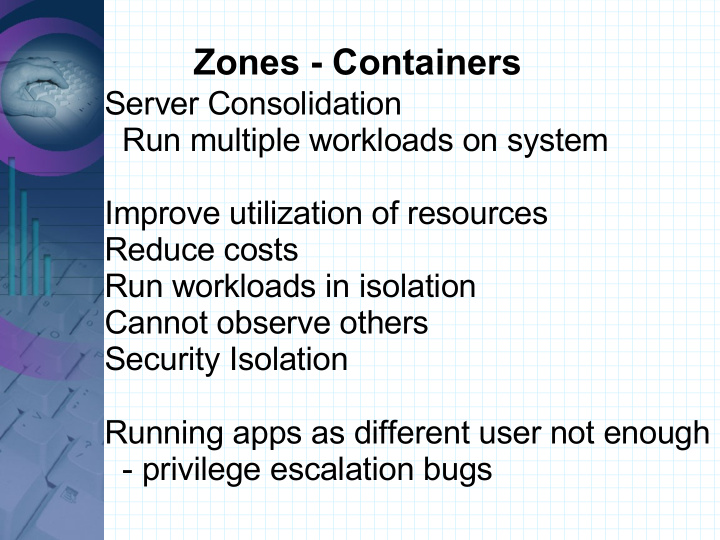



Zones - Containers Server Consolidation Run multiple workloads on system Improve utilization of resources Reduce costs Run workloads in isolation Cannot observe others Security Isolation Running apps as different user not enough - privilege escalation bugs
Solaris Zones Part of Solaris 10 Available on sparc and x86 hardware Applications run with no changes Virtual machine No significant impact on performance
Must solve consolidation problems Name space isolation abstraction Security isolation resource allocation management Must support commercial applications
A virtual machine SW in zone should work without change Admins should not need special scripts System should look and feel like normal host Work on single cpu systems and multi cpu systems. Support several zones on one system.
Address design principles State model describes life cycle Configuration engine to describe a zone Installation support in zone path Application environment Virtual platform
Zone States Configured : configuration done, not installed yet. Installed : installed according to the configuration. Ready : zsched process created, initialize network and devices. No user processes yet. Running : init is created and rest of env can run for apps. Shutting down : remains in this state until all user processes are destroyed. Down : remains in this state until virt. Platform completely destroyed. Then go to installed.
Global zone The global zone is the default zone traditional single zone system Global zone has access to and controls non-global zones
Non-Global zones A system can have several non-global zones Each can be running different set of services non-global zones are isolated – cannot effect other zones (or even observe them) All zones in a system share resources.
Zone commands zonecfg - to configure zone info stored in xml file zoneadm – used to admin zone subcommands include install, boot, reboot, halt, shutdown zlogin – to log into zone -C option gives access to zone console -z or -Z options added to commands like ps, prstat and others for use in global .
Resource controls Can limit amount of cpu used - limit # of processors used - use fair share scheduling to limit % used Can also limit amount of RAM and swap Placing limits on network usage also planned for the future.
Zone disk usage Full and sparse zones zonecfg is given a dir for zone root read-only lofs mounts used a lot zones can take very little disk space By leveraging ZFS more things are possible
Security considered As part of the design devices are limited only root in global zone can access a zone root filesystem. A zones hacking contest was held.
Examples 3 old servers upgraded to one - advstudies, ntp, cgi - current server has 16 zones on it Add on additional with new zones. Load balance zones - hplab.acad.cis.udel.edu - hplab-lx.acad.cis.udel.edu - sunlab.acad.ece.udel.edu - linuxlab.acad.ece.udel.edu
Operating systems supported Solaris 10 and beyond BrandZ – Currently lx (Linux 2.4.21) is supported. (32bit) - experimental Linux 2.6 kernel Also Solaris 8 zones In the future a 64bit lx? BSD? others?
Other virtual machines Hypervisors Can run full OS from kernel on up - true virtual machines Xen/xVM Vmware Security concerns Resource requirements Managing
Recommend
More recommend